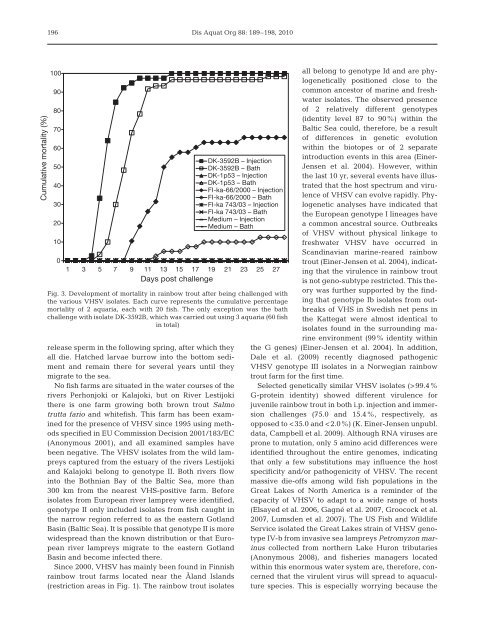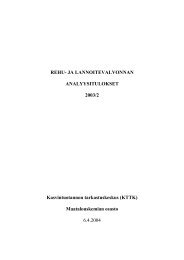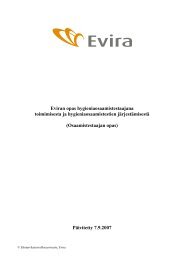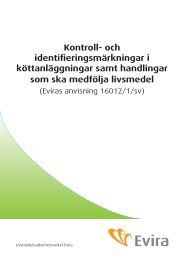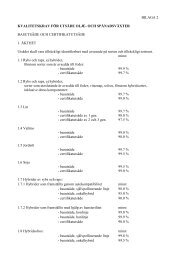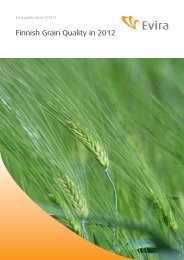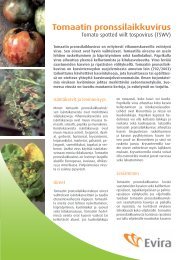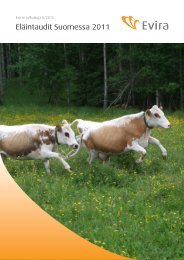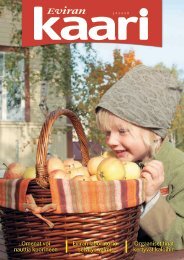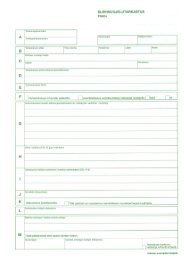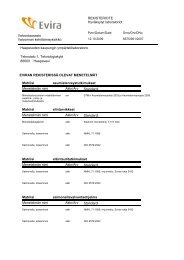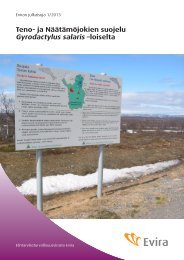Dis Aquat Org - Inter Research
Dis Aquat Org - Inter Research
Dis Aquat Org - Inter Research
You also want an ePaper? Increase the reach of your titles
YUMPU automatically turns print PDFs into web optimized ePapers that Google loves.
Cumulative mortality (%)<br />
196<br />
100<br />
90<br />
80<br />
70<br />
60<br />
50<br />
40<br />
30<br />
20<br />
10<br />
0<br />
release sperm in the following spring, after which they<br />
all die. Hatched larvae burrow into the bottom sediment<br />
and remain there for several years until they<br />
migrate to the sea.<br />
No fish farms are situated in the water courses of the<br />
rivers Perhonjoki or Kalajoki, but on River Lestijoki<br />
there is one farm growing both brown trout Salmo<br />
trutta fario and whitefish. This farm has been examined<br />
for the presence of VHSV since 1995 using methods<br />
specified in EU Commission Decision 2001/183/EC<br />
(Anonymous 2001), and all examined samples have<br />
been negative. The VHSV isolates from the wild lampreys<br />
captured from the estuary of the rivers Lestijoki<br />
and Kalajoki belong to genotype II. Both rivers flow<br />
into the Bothnian Bay of the Baltic Sea, more than<br />
300 km from the nearest VHS-positive farm. Before<br />
isolates from European river lamprey were identified,<br />
genotype II only included isolates from fish caught in<br />
the narrow region referred to as the eastern Gotland<br />
Basin (Baltic Sea). It is possible that genotype II is more<br />
widespread than the known distribution or that European<br />
river lampreys migrate to the eastern Gotland<br />
Basin and become infected there.<br />
Since 2000, VHSV has mainly been found in Finnish<br />
rainbow trout farms located near the Åland Islands<br />
(restriction areas in Fig. 1). The rainbow trout isolates<br />
<strong>Dis</strong> <strong>Aquat</strong> <strong>Org</strong> 88: 189–198, 2010<br />
DK-3592B – Injection<br />
DK-3592B – Bath<br />
DK-1p53 – Injection<br />
DK-1p53 – Bath<br />
FI-ka-66/2000 – Injection<br />
FI-ka-66/2000 – Bath<br />
FI-ka 743/03 – Injection<br />
FI-ka 743/03 – Bath<br />
Medium – Injection<br />
Medium – Bath<br />
1 3 5 7 9 11 13 15 17 19 21 23 25 27<br />
Days post challenge<br />
Fig. 3. Development of mortality in rainbow trout after being challenged with<br />
the various VHSV isolates. Each curve represents the cumulative percentage<br />
mortality of 2 aquaria, each with 20 fish. The only exception was the bath<br />
challenge with isolate DK-3592B, which was carried out using 3 aquaria (60 fish<br />
in total)<br />
all belong to genotype Id and are phylogenetically<br />
positioned close to the<br />
common ancestor of marine and freshwater<br />
isolates. The observed presence<br />
of 2 relatively different genotypes<br />
(identity level 87 to 90%) within the<br />
Baltic Sea could, therefore, be a result<br />
of differences in genetic evolution<br />
within the biotopes or of 2 separate<br />
introduction events in this area (Einer-<br />
Jensen et al. 2004). However, within<br />
the last 10 yr, several events have illustrated<br />
that the host spectrum and virulence<br />
of VHSV can evolve rapidly. Phylogenetic<br />
analyses have indicated that<br />
the European genotype I lineages have<br />
a common ancestral source. Outbreaks<br />
of VHSV without physical linkage to<br />
freshwater VHSV have occurred in<br />
Scandinavian marine-reared rainbow<br />
trout (Einer-Jensen et al. 2004), indicating<br />
that the virulence in rainbow trout<br />
is not geno-subtype restricted. This theory<br />
was further supported by the finding<br />
that genotype Ib isolates from outbreaks<br />
of VHS in Swedish net pens in<br />
the Kattegat were almost identical to<br />
isolates found in the surrounding marine<br />
environment (99% identity within<br />
the G genes) (Einer-Jensen et al. 2004). In addition,<br />
Dale et al. (2009) recently diagnosed pathogenic<br />
VHSV genotype III isolates in a Norwegian rainbow<br />
trout farm for the first time.<br />
Selected genetically similar VHSV isolates (>99.4%<br />
G-protein identity) showed different virulence for<br />
juvenile rainbow trout in both i.p. injection and immersion<br />
challenges (75.0 and 15.4%, respectively, as<br />
opposed to


